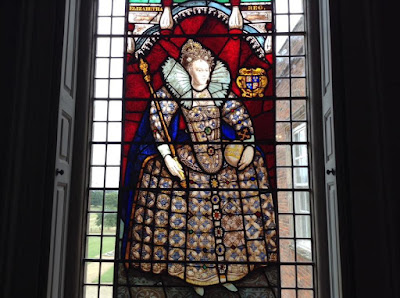Melford Hall, Queen Elizabeth Portrait, Stained Glass
Melford Hall, Suffolk, National Trust Property; National Trust for Places of Historic Interest and Natural Beauty
Melford Hall is a property with a history interesting female inhabitants and visitors and, in celebration of this, we remember the lives of Elizabeth, Countess Rivers and Ulla, Lady Hyde Parker and the impact they had on the house they loved.
Melford Hall has had a long and varied history. Now the family home of the Hyde Parks, over five hundred years ago the estate was owned by the Abbots of St. Edmundsbury.
1. Abbots of St Edmundsbury1000s-1500s:
For around five hundred years Melford was owned by the Abbots of St Edmundsbury. Although the site has been extensively altered remnants of the lives of the abbots remain.
The cellars, which cannot be accessed by members of the public, were used as rooms during this period.
1536: Early in the sixteenth century Henry VIII became leader of the Church of England, severing England’s previous ecclesiastical ties with the Papacy. The dissolution of the monasteries, in which Henry VIII took possession of many houses of religion, affected Melford.
It became a royal property in
1539 and was leased to Sir William Cordell, a member of the rising middle classes.
His early life was spent at Kentwell Hall where his father was a steward.
William’s success was largely thanks to the Cloptons, the proprietors of Kentwell. They sponsored him to go to London to train as a lawyer. Sir William Cordell was granted the estate of Melford in 1554 by Queen Mary I having helped her accede to the throne.
The Pavilion in the Garden at Melford Hall, Suffolk, UK
2. A new era:
the Cordells1539-1581: Sir William Cordell greatly modified Melford on becoming its owner, making it a grand and impressive family home.
The visit of Queen Elizabeth I in
1578 is testimony to both William’s social position during the Enlightenment and his renovation work on this building.
It was clearly viewed as a suitable location for the entertainment of royalty.
1581: Following the death of Sir William Cordell in 1581, followed by his wife Mary four years later, Melford Hall passed to Jane Allington, William’s sister.
She appeared to have lived mostly in London and to have neglected the house.
On her death Melford was bequeathed to her grandson, Thomas Viscount Savage, who came from an ancient Cheshire family.

Aerial view of Melford Hall in Suffolk, UK
3. The proprietorship of Thomas Savage1602:
Near the start of the seventeenth century Thomas Savage inherited Melford and many changes were carried out, possibly as a result of needing to accommodate his nineteen children. The house was refurbished in the style of the time. A lawyer, initially at the court of James I and later Charles I, Savage was appointed Chancellor of the Household to Queen Henrietta Maria.
His wife Elizabeth also served as a lady-in-waiting to the Queen.
1635: After over thirty years of owning Melford Thomas Savage passed away. His wife Elizabeth remained at Melford for several years. Always short of funds, Elizabeth mortgaged the estate. During the Civil War Melford Hall, as a home of Catholic Royalists, was ransacked and Elizabeth’s son was forced to surrender the property to Robert Cordell, his mortgagor.
Melford Hall Interior
4. The Cordells own Melford Hall again1651:
Sir Robert Cordell became the owner of Melford, the Savage’s having insufficient funds to keep the house.
The hall was in a bad condition due to it having been
vandalised during the Civil War.
Robert was the MP for Sudbury and Sheriff of the county and he undertook a programme of refurbishment and reparation.
He was succeeded by a son and grandson.
1704: Near the beginning of the eighteenth century John Cordell, the descendant of Sir Robert, passed away childless and Melford was inherited by his sister
Margaret Firebrace.
Tudor Country Manor
5. The Firebraces, 1727:
Sir Cordell Firebrace, Margaret’s son, took over Melford.
He decorated and renovated the house to fit the styles and wants of the eighteenth century.
1759: Firebrace made many alterations to the house.
In 1759 he died childless, resulting in the property leaving the possession of the Firebrace line.
The present: the family home of the Hyde Parkers1786: Near the end of the eighteenth century the house was put on the market for the first and only time in its long history. It was sold to Harry Parker by the third husband of the deceased Firebrace’s wife, William Campbell. The Hyde Parkers who have modified the house through the ensuing period, still live in Melford Hall to this day.
Melford Hall, National Trust
Reference:
https://www.nationaltrust.org.uk/melford-hall/lists/melford-halls-ownership-through-the-centuries












Comments
Post a Comment